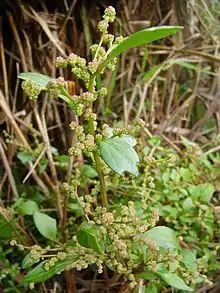Oxybasis chenopodioides
Oxybasis chenopodioides,[1] (syn. Chenopodium chenopodioides) is a species of flowering plant in the family Amaranthaceae known by the common name low goosefoot.
| Oxybasis chenopodioides | |
|---|---|
 | |
| A flowering low goosefoot plant | |
| Scientific classification | |
| Kingdom: | Plantae |
| Clade: | Tracheophytes |
| Clade: | Angiosperms |
| Clade: | Eudicots |
| Order: | Caryophyllales |
| Family: | Amaranthaceae |
| Genus: | Oxybasis |
| Species: | O. chenopodioides |
| Binomial name | |
| Oxybasis chenopodioides | |
| Synonyms | |
|
Blitum chenopodioides L. | |
It is native to South America,[2] but it is known in widespread parts of Africa, Asia, Europe, and North America as an introduced species.[3]
It grows in wet non-saline and saline soils, such as mudflats, salt marshes, and lake margins.
It is an annual herb growing erect to heights approaching 35 to 45 centimeters, or prostrate in a creeping mat. It is green to magenta in color and non-aromatic. The leaves may be several centimeters long and vary in shape from smooth-edged and oval to triangular and lobed or toothed. The inflorescence is a small, dense cluster of tiny flowers, each flower with its three-lobed calyx enclosing the developing fruit.
References
- Susy Fuentes-Bazan, Pertti Uotila, Thomas Borsch: A novel phylogeny-based generic classification for Chenopodium sensu lato, and a tribal rearrangement of Chenopodioideae (Chenopodiaceae). In: Willdenowia. Vol. 42, No. 1, 2012, p. 15-16.
- Jepson Manual Treatment
- Flora of China
External links